Impact of Workplace Transformation on Employee Productivity: A Case Study of Keller Williams UK
VerifiedAdded on 2023/06/08
|19
|4097
|282
AI Summary
This report evaluates the impact of workplace transformation on employee productivity in relation to designing and building spacious offices. It includes a literature review, research methodology, data analysis, and findings. The report also suggests strategies for Keller Williams UK to implement drastic workplace transformation in terms of infrastructural facilities.
Contribute Materials
Your contribution can guide someone’s learning journey. Share your
documents today.
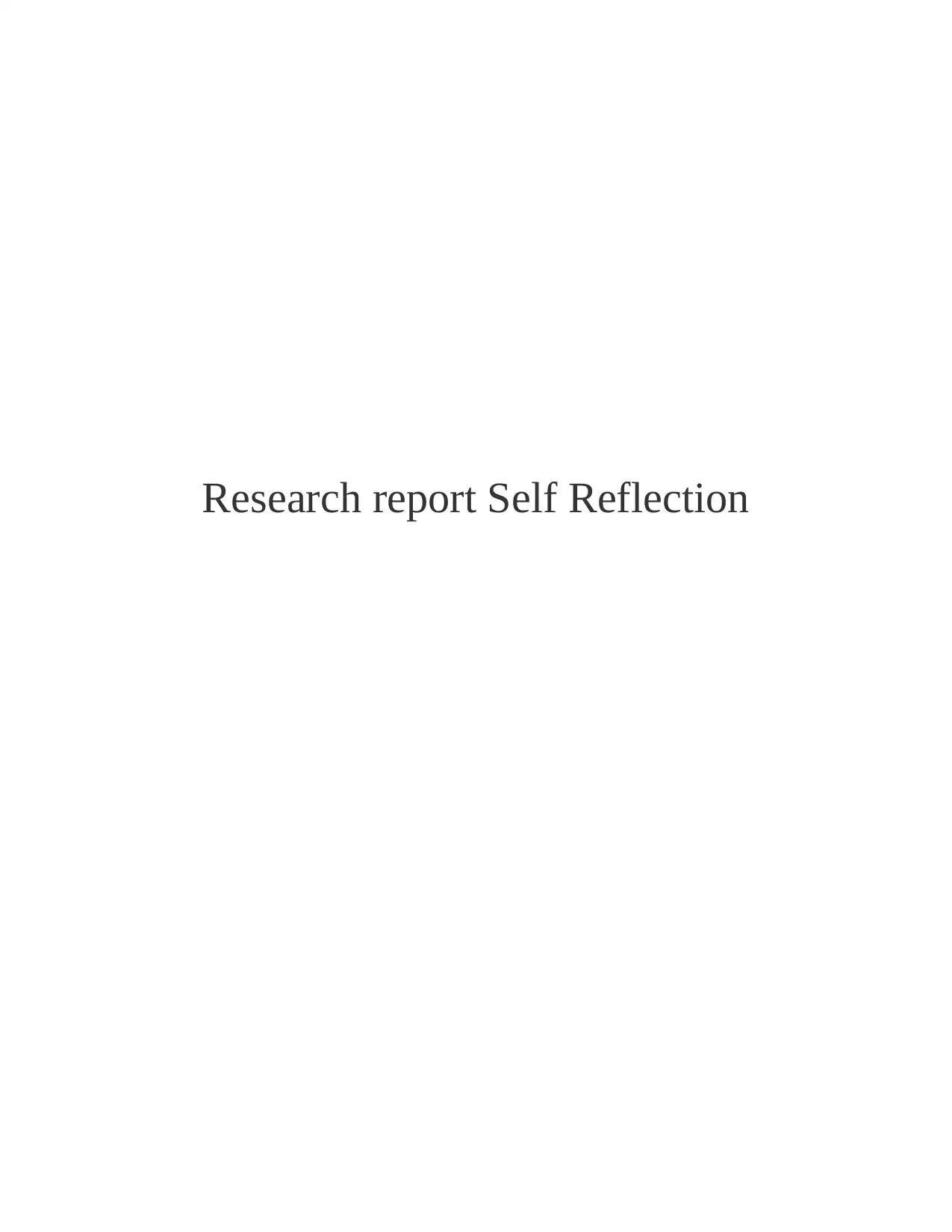
Research report Self Reflection
Secure Best Marks with AI Grader
Need help grading? Try our AI Grader for instant feedback on your assignments.
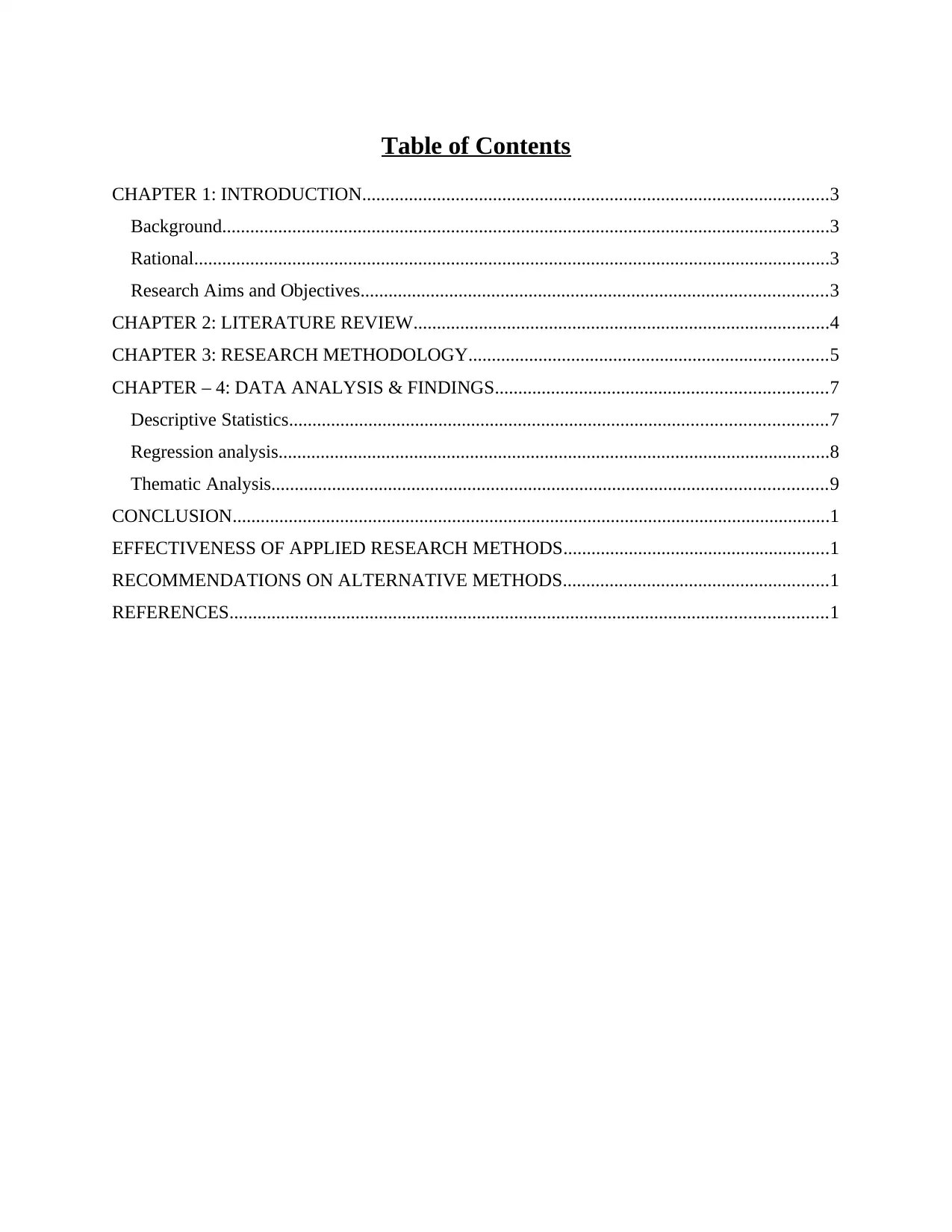
Table of Contents
CHAPTER 1: INTRODUCTION....................................................................................................3
Background..................................................................................................................................3
Rational........................................................................................................................................3
Research Aims and Objectives....................................................................................................3
CHAPTER 2: LITERATURE REVIEW.........................................................................................4
CHAPTER 3: RESEARCH METHODOLOGY.............................................................................5
CHAPTER – 4: DATA ANALYSIS & FINDINGS.......................................................................7
Descriptive Statistics...................................................................................................................7
Regression analysis......................................................................................................................8
Thematic Analysis.......................................................................................................................9
CONCLUSION................................................................................................................................1
EFFECTIVENESS OF APPLIED RESEARCH METHODS.........................................................1
RECOMMENDATIONS ON ALTERNATIVE METHODS.........................................................1
REFERENCES................................................................................................................................1
CHAPTER 1: INTRODUCTION....................................................................................................3
Background..................................................................................................................................3
Rational........................................................................................................................................3
Research Aims and Objectives....................................................................................................3
CHAPTER 2: LITERATURE REVIEW.........................................................................................4
CHAPTER 3: RESEARCH METHODOLOGY.............................................................................5
CHAPTER – 4: DATA ANALYSIS & FINDINGS.......................................................................7
Descriptive Statistics...................................................................................................................7
Regression analysis......................................................................................................................8
Thematic Analysis.......................................................................................................................9
CONCLUSION................................................................................................................................1
EFFECTIVENESS OF APPLIED RESEARCH METHODS.........................................................1
RECOMMENDATIONS ON ALTERNATIVE METHODS.........................................................1
REFERENCES................................................................................................................................1
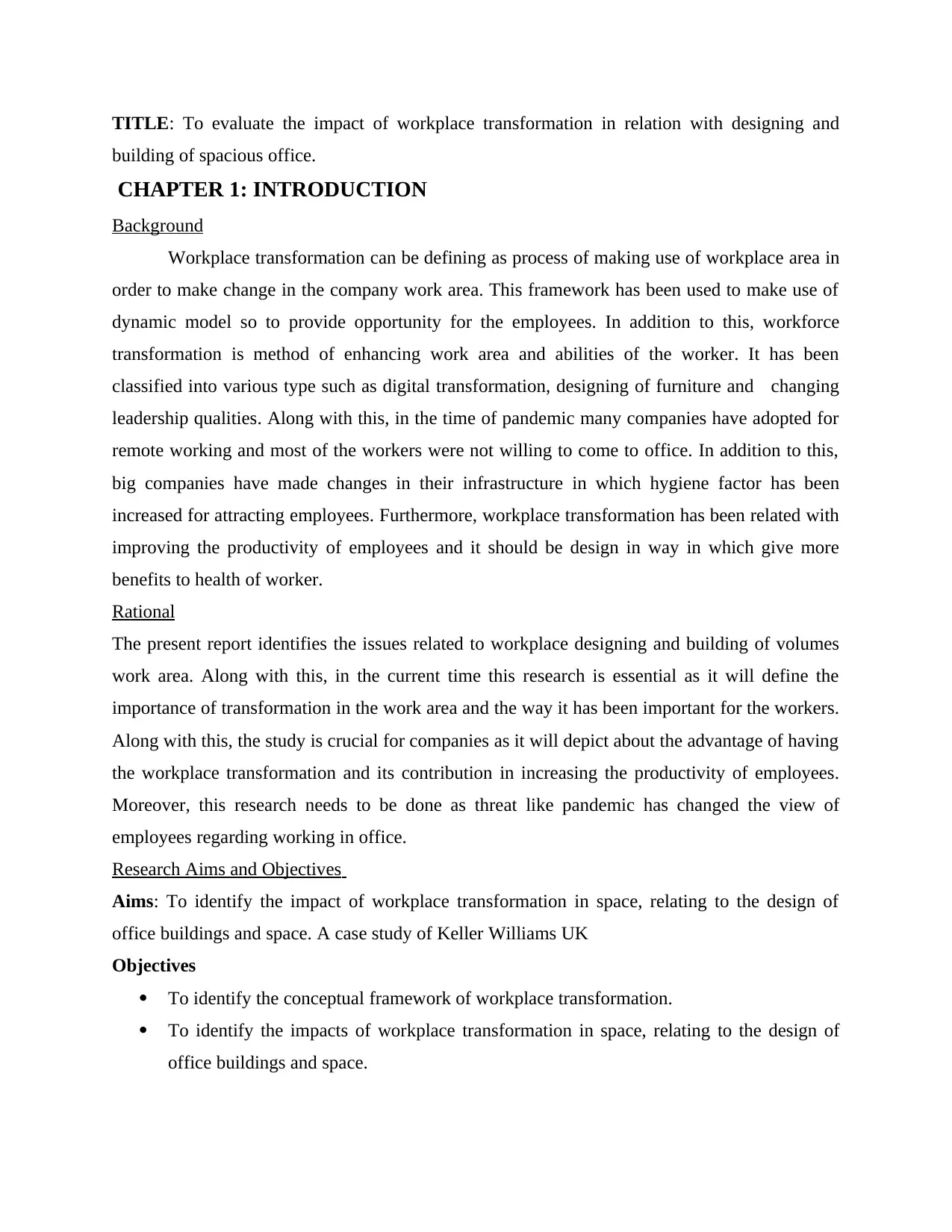
TITLE: To evaluate the impact of workplace transformation in relation with designing and
building of spacious office.
CHAPTER 1: INTRODUCTION
Background
Workplace transformation can be defining as process of making use of workplace area in
order to make change in the company work area. This framework has been used to make use of
dynamic model so to provide opportunity for the employees. In addition to this, workforce
transformation is method of enhancing work area and abilities of the worker. It has been
classified into various type such as digital transformation, designing of furniture and changing
leadership qualities. Along with this, in the time of pandemic many companies have adopted for
remote working and most of the workers were not willing to come to office. In addition to this,
big companies have made changes in their infrastructure in which hygiene factor has been
increased for attracting employees. Furthermore, workplace transformation has been related with
improving the productivity of employees and it should be design in way in which give more
benefits to health of worker.
Rational
The present report identifies the issues related to workplace designing and building of volumes
work area. Along with this, in the current time this research is essential as it will define the
importance of transformation in the work area and the way it has been important for the workers.
Along with this, the study is crucial for companies as it will depict about the advantage of having
the workplace transformation and its contribution in increasing the productivity of employees.
Moreover, this research needs to be done as threat like pandemic has changed the view of
employees regarding working in office.
Research Aims and Objectives
Aims: To identify the impact of workplace transformation in space, relating to the design of
office buildings and space. A case study of Keller Williams UK
Objectives
To identify the conceptual framework of workplace transformation.
To identify the impacts of workplace transformation in space, relating to the design of
office buildings and space.
building of spacious office.
CHAPTER 1: INTRODUCTION
Background
Workplace transformation can be defining as process of making use of workplace area in
order to make change in the company work area. This framework has been used to make use of
dynamic model so to provide opportunity for the employees. In addition to this, workforce
transformation is method of enhancing work area and abilities of the worker. It has been
classified into various type such as digital transformation, designing of furniture and changing
leadership qualities. Along with this, in the time of pandemic many companies have adopted for
remote working and most of the workers were not willing to come to office. In addition to this,
big companies have made changes in their infrastructure in which hygiene factor has been
increased for attracting employees. Furthermore, workplace transformation has been related with
improving the productivity of employees and it should be design in way in which give more
benefits to health of worker.
Rational
The present report identifies the issues related to workplace designing and building of volumes
work area. Along with this, in the current time this research is essential as it will define the
importance of transformation in the work area and the way it has been important for the workers.
Along with this, the study is crucial for companies as it will depict about the advantage of having
the workplace transformation and its contribution in increasing the productivity of employees.
Moreover, this research needs to be done as threat like pandemic has changed the view of
employees regarding working in office.
Research Aims and Objectives
Aims: To identify the impact of workplace transformation in space, relating to the design of
office buildings and space. A case study of Keller Williams UK
Objectives
To identify the conceptual framework of workplace transformation.
To identify the impacts of workplace transformation in space, relating to the design of
office buildings and space.
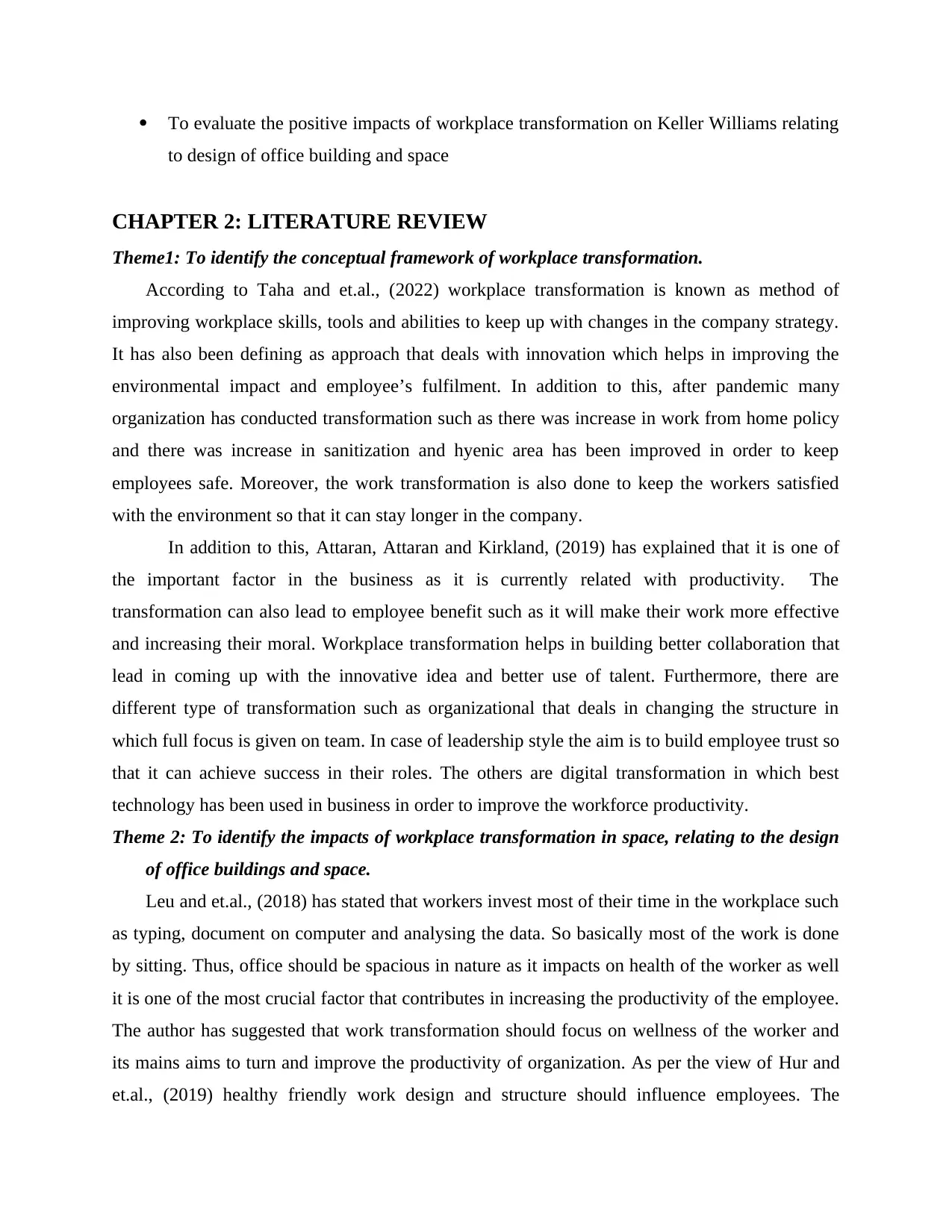
To evaluate the positive impacts of workplace transformation on Keller Williams relating
to design of office building and space
CHAPTER 2: LITERATURE REVIEW
Theme1: To identify the conceptual framework of workplace transformation.
According to Taha and et.al., (2022) workplace transformation is known as method of
improving workplace skills, tools and abilities to keep up with changes in the company strategy.
It has also been defining as approach that deals with innovation which helps in improving the
environmental impact and employee’s fulfilment. In addition to this, after pandemic many
organization has conducted transformation such as there was increase in work from home policy
and there was increase in sanitization and hyenic area has been improved in order to keep
employees safe. Moreover, the work transformation is also done to keep the workers satisfied
with the environment so that it can stay longer in the company.
In addition to this, Attaran, Attaran and Kirkland, (2019) has explained that it is one of
the important factor in the business as it is currently related with productivity. The
transformation can also lead to employee benefit such as it will make their work more effective
and increasing their moral. Workplace transformation helps in building better collaboration that
lead in coming up with the innovative idea and better use of talent. Furthermore, there are
different type of transformation such as organizational that deals in changing the structure in
which full focus is given on team. In case of leadership style the aim is to build employee trust so
that it can achieve success in their roles. The others are digital transformation in which best
technology has been used in business in order to improve the workforce productivity.
Theme 2: To identify the impacts of workplace transformation in space, relating to the design
of office buildings and space.
Leu and et.al., (2018) has stated that workers invest most of their time in the workplace such
as typing, document on computer and analysing the data. So basically most of the work is done
by sitting. Thus, office should be spacious in nature as it impacts on health of the worker as well
it is one of the most crucial factor that contributes in increasing the productivity of the employee.
The author has suggested that work transformation should focus on wellness of the worker and
its mains aims to turn and improve the productivity of organization. As per the view of Hur and
et.al., (2019) healthy friendly work design and structure should influence employees. The
to design of office building and space
CHAPTER 2: LITERATURE REVIEW
Theme1: To identify the conceptual framework of workplace transformation.
According to Taha and et.al., (2022) workplace transformation is known as method of
improving workplace skills, tools and abilities to keep up with changes in the company strategy.
It has also been defining as approach that deals with innovation which helps in improving the
environmental impact and employee’s fulfilment. In addition to this, after pandemic many
organization has conducted transformation such as there was increase in work from home policy
and there was increase in sanitization and hyenic area has been improved in order to keep
employees safe. Moreover, the work transformation is also done to keep the workers satisfied
with the environment so that it can stay longer in the company.
In addition to this, Attaran, Attaran and Kirkland, (2019) has explained that it is one of
the important factor in the business as it is currently related with productivity. The
transformation can also lead to employee benefit such as it will make their work more effective
and increasing their moral. Workplace transformation helps in building better collaboration that
lead in coming up with the innovative idea and better use of talent. Furthermore, there are
different type of transformation such as organizational that deals in changing the structure in
which full focus is given on team. In case of leadership style the aim is to build employee trust so
that it can achieve success in their roles. The others are digital transformation in which best
technology has been used in business in order to improve the workforce productivity.
Theme 2: To identify the impacts of workplace transformation in space, relating to the design
of office buildings and space.
Leu and et.al., (2018) has stated that workers invest most of their time in the workplace such
as typing, document on computer and analysing the data. So basically most of the work is done
by sitting. Thus, office should be spacious in nature as it impacts on health of the worker as well
it is one of the most crucial factor that contributes in increasing the productivity of the employee.
The author has suggested that work transformation should focus on wellness of the worker and
its mains aims to turn and improve the productivity of organization. As per the view of Hur and
et.al., (2019) healthy friendly work design and structure should influence employees. The
Secure Best Marks with AI Grader
Need help grading? Try our AI Grader for instant feedback on your assignments.
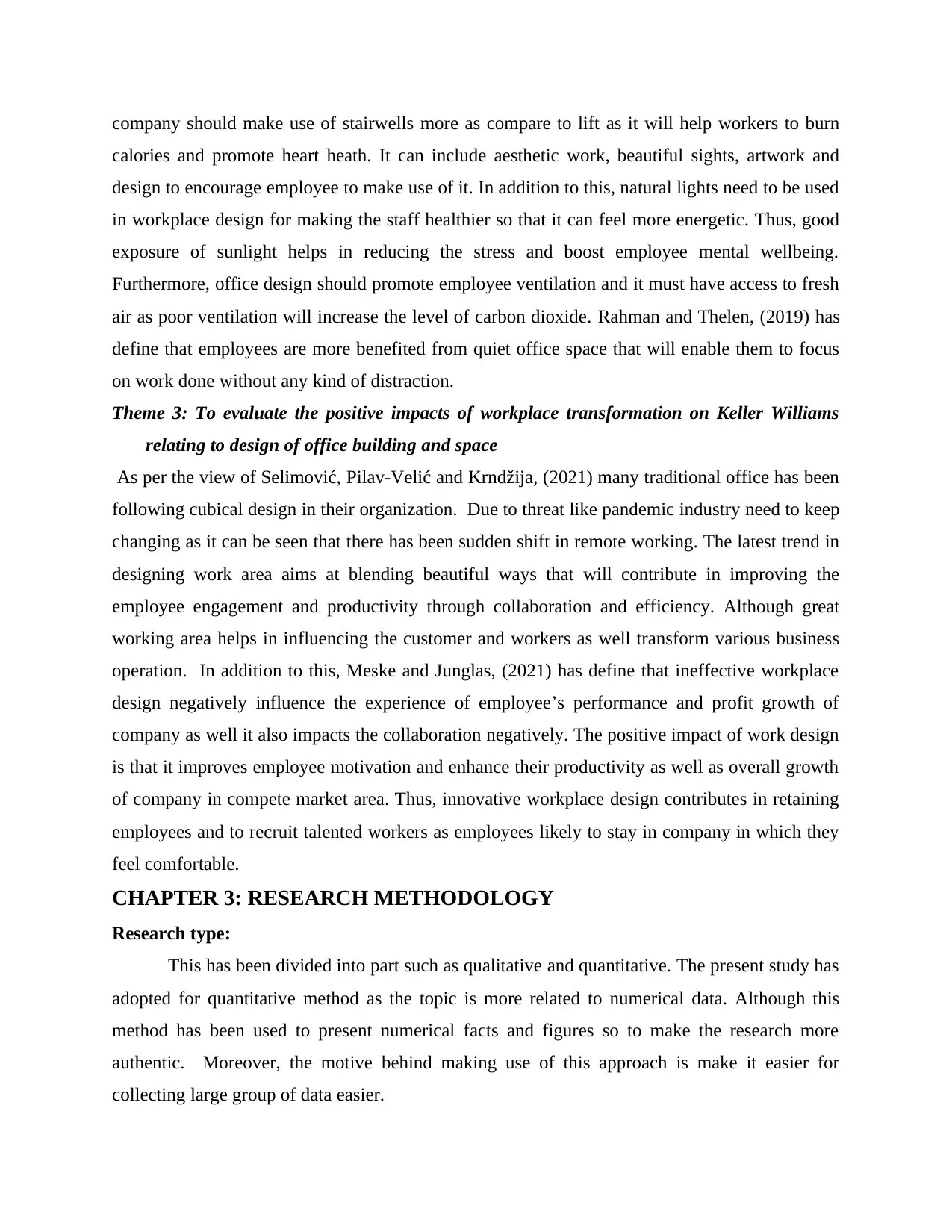
company should make use of stairwells more as compare to lift as it will help workers to burn
calories and promote heart heath. It can include aesthetic work, beautiful sights, artwork and
design to encourage employee to make use of it. In addition to this, natural lights need to be used
in workplace design for making the staff healthier so that it can feel more energetic. Thus, good
exposure of sunlight helps in reducing the stress and boost employee mental wellbeing.
Furthermore, office design should promote employee ventilation and it must have access to fresh
air as poor ventilation will increase the level of carbon dioxide. Rahman and Thelen, (2019) has
define that employees are more benefited from quiet office space that will enable them to focus
on work done without any kind of distraction.
Theme 3: To evaluate the positive impacts of workplace transformation on Keller Williams
relating to design of office building and space
As per the view of Selimović, Pilav-Velić and Krndžija, (2021) many traditional office has been
following cubical design in their organization. Due to threat like pandemic industry need to keep
changing as it can be seen that there has been sudden shift in remote working. The latest trend in
designing work area aims at blending beautiful ways that will contribute in improving the
employee engagement and productivity through collaboration and efficiency. Although great
working area helps in influencing the customer and workers as well transform various business
operation. In addition to this, Meske and Junglas, (2021) has define that ineffective workplace
design negatively influence the experience of employee’s performance and profit growth of
company as well it also impacts the collaboration negatively. The positive impact of work design
is that it improves employee motivation and enhance their productivity as well as overall growth
of company in compete market area. Thus, innovative workplace design contributes in retaining
employees and to recruit talented workers as employees likely to stay in company in which they
feel comfortable.
CHAPTER 3: RESEARCH METHODOLOGY
Research type:
This has been divided into part such as qualitative and quantitative. The present study has
adopted for quantitative method as the topic is more related to numerical data. Although this
method has been used to present numerical facts and figures so to make the research more
authentic. Moreover, the motive behind making use of this approach is make it easier for
collecting large group of data easier.
calories and promote heart heath. It can include aesthetic work, beautiful sights, artwork and
design to encourage employee to make use of it. In addition to this, natural lights need to be used
in workplace design for making the staff healthier so that it can feel more energetic. Thus, good
exposure of sunlight helps in reducing the stress and boost employee mental wellbeing.
Furthermore, office design should promote employee ventilation and it must have access to fresh
air as poor ventilation will increase the level of carbon dioxide. Rahman and Thelen, (2019) has
define that employees are more benefited from quiet office space that will enable them to focus
on work done without any kind of distraction.
Theme 3: To evaluate the positive impacts of workplace transformation on Keller Williams
relating to design of office building and space
As per the view of Selimović, Pilav-Velić and Krndžija, (2021) many traditional office has been
following cubical design in their organization. Due to threat like pandemic industry need to keep
changing as it can be seen that there has been sudden shift in remote working. The latest trend in
designing work area aims at blending beautiful ways that will contribute in improving the
employee engagement and productivity through collaboration and efficiency. Although great
working area helps in influencing the customer and workers as well transform various business
operation. In addition to this, Meske and Junglas, (2021) has define that ineffective workplace
design negatively influence the experience of employee’s performance and profit growth of
company as well it also impacts the collaboration negatively. The positive impact of work design
is that it improves employee motivation and enhance their productivity as well as overall growth
of company in compete market area. Thus, innovative workplace design contributes in retaining
employees and to recruit talented workers as employees likely to stay in company in which they
feel comfortable.
CHAPTER 3: RESEARCH METHODOLOGY
Research type:
This has been divided into part such as qualitative and quantitative. The present study has
adopted for quantitative method as the topic is more related to numerical data. Although this
method has been used to present numerical facts and figures so to make the research more
authentic. Moreover, the motive behind making use of this approach is make it easier for
collecting large group of data easier.
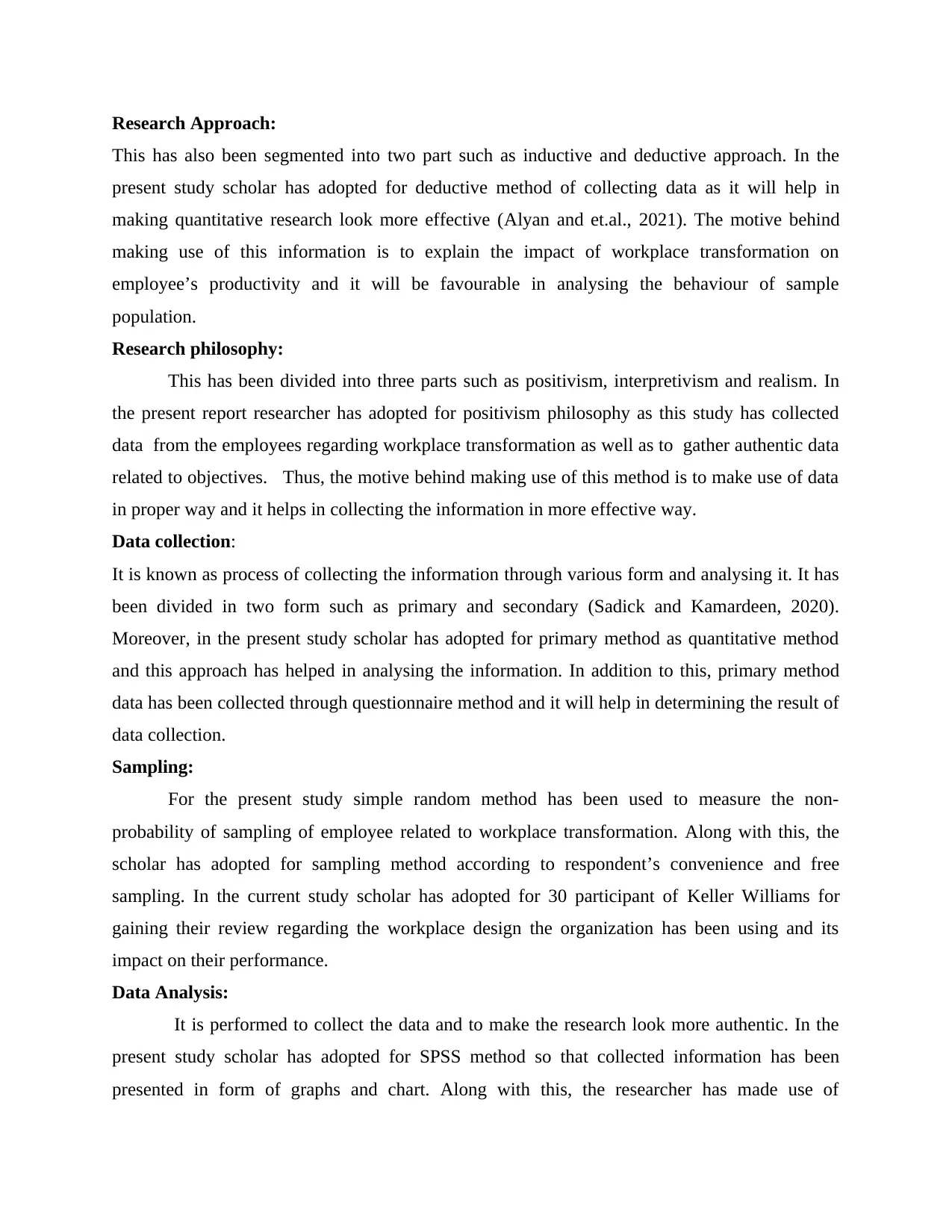
Research Approach:
This has also been segmented into two part such as inductive and deductive approach. In the
present study scholar has adopted for deductive method of collecting data as it will help in
making quantitative research look more effective (Alyan and et.al., 2021). The motive behind
making use of this information is to explain the impact of workplace transformation on
employee’s productivity and it will be favourable in analysing the behaviour of sample
population.
Research philosophy:
This has been divided into three parts such as positivism, interpretivism and realism. In
the present report researcher has adopted for positivism philosophy as this study has collected
data from the employees regarding workplace transformation as well as to gather authentic data
related to objectives. Thus, the motive behind making use of this method is to make use of data
in proper way and it helps in collecting the information in more effective way.
Data collection:
It is known as process of collecting the information through various form and analysing it. It has
been divided in two form such as primary and secondary (Sadick and Kamardeen, 2020).
Moreover, in the present study scholar has adopted for primary method as quantitative method
and this approach has helped in analysing the information. In addition to this, primary method
data has been collected through questionnaire method and it will help in determining the result of
data collection.
Sampling:
For the present study simple random method has been used to measure the non-
probability of sampling of employee related to workplace transformation. Along with this, the
scholar has adopted for sampling method according to respondent’s convenience and free
sampling. In the current study scholar has adopted for 30 participant of Keller Williams for
gaining their review regarding the workplace design the organization has been using and its
impact on their performance.
Data Analysis:
It is performed to collect the data and to make the research look more authentic. In the
present study scholar has adopted for SPSS method so that collected information has been
presented in form of graphs and chart. Along with this, the researcher has made use of
This has also been segmented into two part such as inductive and deductive approach. In the
present study scholar has adopted for deductive method of collecting data as it will help in
making quantitative research look more effective (Alyan and et.al., 2021). The motive behind
making use of this information is to explain the impact of workplace transformation on
employee’s productivity and it will be favourable in analysing the behaviour of sample
population.
Research philosophy:
This has been divided into three parts such as positivism, interpretivism and realism. In
the present report researcher has adopted for positivism philosophy as this study has collected
data from the employees regarding workplace transformation as well as to gather authentic data
related to objectives. Thus, the motive behind making use of this method is to make use of data
in proper way and it helps in collecting the information in more effective way.
Data collection:
It is known as process of collecting the information through various form and analysing it. It has
been divided in two form such as primary and secondary (Sadick and Kamardeen, 2020).
Moreover, in the present study scholar has adopted for primary method as quantitative method
and this approach has helped in analysing the information. In addition to this, primary method
data has been collected through questionnaire method and it will help in determining the result of
data collection.
Sampling:
For the present study simple random method has been used to measure the non-
probability of sampling of employee related to workplace transformation. Along with this, the
scholar has adopted for sampling method according to respondent’s convenience and free
sampling. In the current study scholar has adopted for 30 participant of Keller Williams for
gaining their review regarding the workplace design the organization has been using and its
impact on their performance.
Data Analysis:
It is performed to collect the data and to make the research look more authentic. In the
present study scholar has adopted for SPSS method so that collected information has been
presented in form of graphs and chart. Along with this, the researcher has made use of
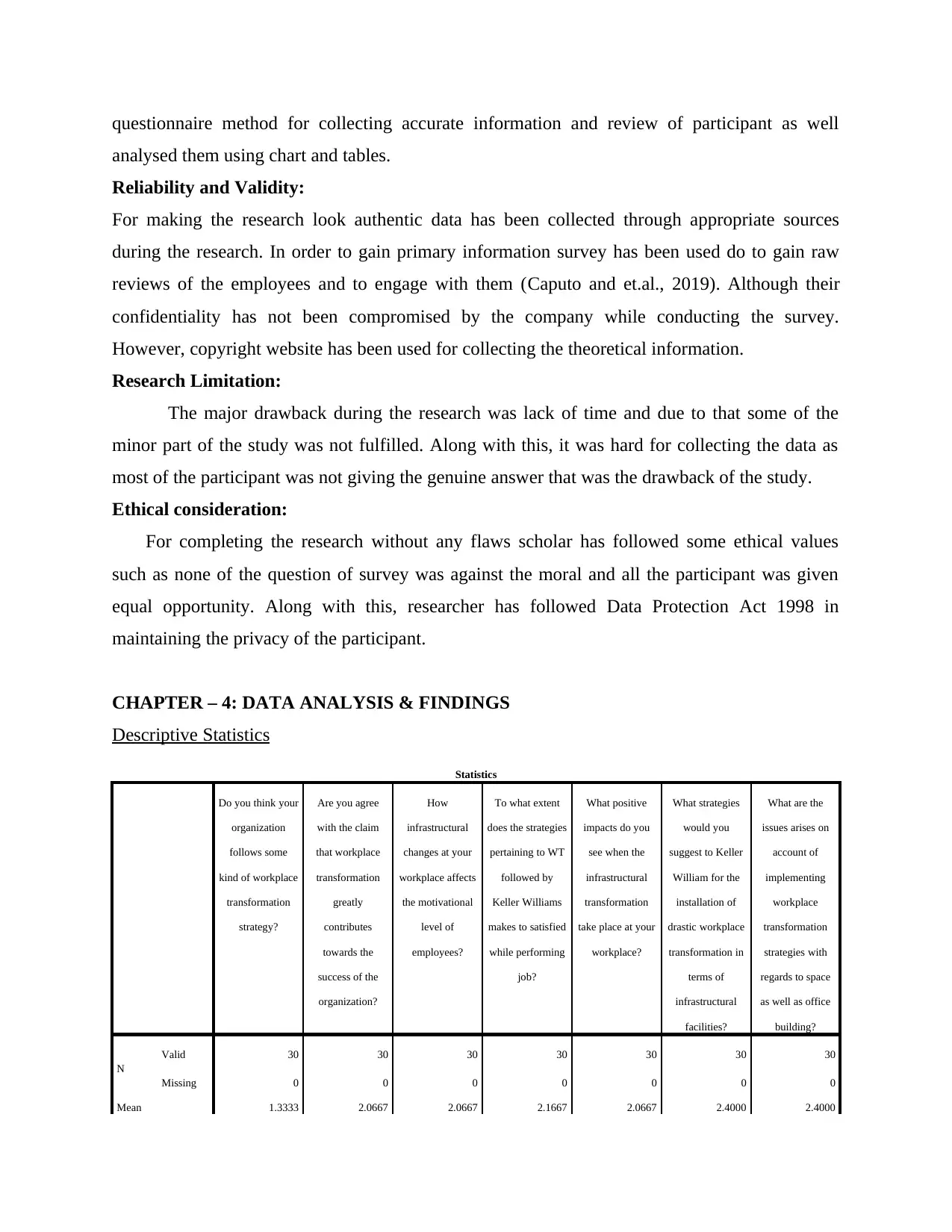
questionnaire method for collecting accurate information and review of participant as well
analysed them using chart and tables.
Reliability and Validity:
For making the research look authentic data has been collected through appropriate sources
during the research. In order to gain primary information survey has been used do to gain raw
reviews of the employees and to engage with them (Caputo and et.al., 2019). Although their
confidentiality has not been compromised by the company while conducting the survey.
However, copyright website has been used for collecting the theoretical information.
Research Limitation:
The major drawback during the research was lack of time and due to that some of the
minor part of the study was not fulfilled. Along with this, it was hard for collecting the data as
most of the participant was not giving the genuine answer that was the drawback of the study.
Ethical consideration:
For completing the research without any flaws scholar has followed some ethical values
such as none of the question of survey was against the moral and all the participant was given
equal opportunity. Along with this, researcher has followed Data Protection Act 1998 in
maintaining the privacy of the participant.
CHAPTER – 4: DATA ANALYSIS & FINDINGS
Descriptive Statistics
Statistics
Do you think your
organization
follows some
kind of workplace
transformation
strategy?
Are you agree
with the claim
that workplace
transformation
greatly
contributes
towards the
success of the
organization?
How
infrastructural
changes at your
workplace affects
the motivational
level of
employees?
To what extent
does the strategies
pertaining to WT
followed by
Keller Williams
makes to satisfied
while performing
job?
What positive
impacts do you
see when the
infrastructural
transformation
take place at your
workplace?
What strategies
would you
suggest to Keller
William for the
installation of
drastic workplace
transformation in
terms of
infrastructural
facilities?
What are the
issues arises on
account of
implementing
workplace
transformation
strategies with
regards to space
as well as office
building?
N
Valid 30 30 30 30 30 30 30
Missing 0 0 0 0 0 0 0
Mean 1.3333 2.0667 2.0667 2.1667 2.0667 2.4000 2.4000
analysed them using chart and tables.
Reliability and Validity:
For making the research look authentic data has been collected through appropriate sources
during the research. In order to gain primary information survey has been used do to gain raw
reviews of the employees and to engage with them (Caputo and et.al., 2019). Although their
confidentiality has not been compromised by the company while conducting the survey.
However, copyright website has been used for collecting the theoretical information.
Research Limitation:
The major drawback during the research was lack of time and due to that some of the
minor part of the study was not fulfilled. Along with this, it was hard for collecting the data as
most of the participant was not giving the genuine answer that was the drawback of the study.
Ethical consideration:
For completing the research without any flaws scholar has followed some ethical values
such as none of the question of survey was against the moral and all the participant was given
equal opportunity. Along with this, researcher has followed Data Protection Act 1998 in
maintaining the privacy of the participant.
CHAPTER – 4: DATA ANALYSIS & FINDINGS
Descriptive Statistics
Statistics
Do you think your
organization
follows some
kind of workplace
transformation
strategy?
Are you agree
with the claim
that workplace
transformation
greatly
contributes
towards the
success of the
organization?
How
infrastructural
changes at your
workplace affects
the motivational
level of
employees?
To what extent
does the strategies
pertaining to WT
followed by
Keller Williams
makes to satisfied
while performing
job?
What positive
impacts do you
see when the
infrastructural
transformation
take place at your
workplace?
What strategies
would you
suggest to Keller
William for the
installation of
drastic workplace
transformation in
terms of
infrastructural
facilities?
What are the
issues arises on
account of
implementing
workplace
transformation
strategies with
regards to space
as well as office
building?
N
Valid 30 30 30 30 30 30 30
Missing 0 0 0 0 0 0 0
Mean 1.3333 2.0667 2.0667 2.1667 2.0667 2.4000 2.4000
Paraphrase This Document
Need a fresh take? Get an instant paraphrase of this document with our AI Paraphraser
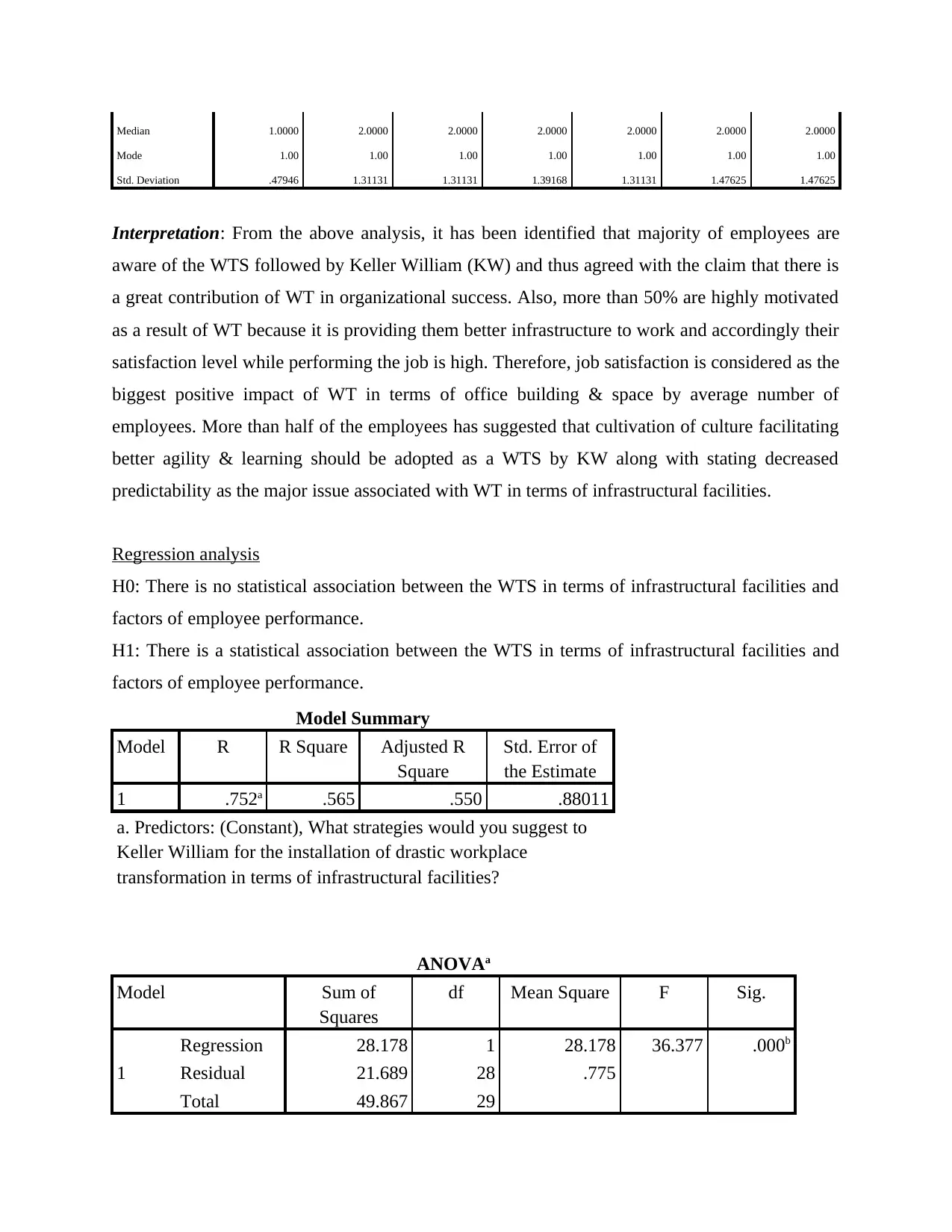
Median 1.0000 2.0000 2.0000 2.0000 2.0000 2.0000 2.0000
Mode 1.00 1.00 1.00 1.00 1.00 1.00 1.00
Std. Deviation .47946 1.31131 1.31131 1.39168 1.31131 1.47625 1.47625
Interpretation: From the above analysis, it has been identified that majority of employees are
aware of the WTS followed by Keller William (KW) and thus agreed with the claim that there is
a great contribution of WT in organizational success. Also, more than 50% are highly motivated
as a result of WT because it is providing them better infrastructure to work and accordingly their
satisfaction level while performing the job is high. Therefore, job satisfaction is considered as the
biggest positive impact of WT in terms of office building & space by average number of
employees. More than half of the employees has suggested that cultivation of culture facilitating
better agility & learning should be adopted as a WTS by KW along with stating decreased
predictability as the major issue associated with WT in terms of infrastructural facilities.
Regression analysis
H0: There is no statistical association between the WTS in terms of infrastructural facilities and
factors of employee performance.
H1: There is a statistical association between the WTS in terms of infrastructural facilities and
factors of employee performance.
Model Summary
Model R R Square Adjusted R
Square
Std. Error of
the Estimate
1 .752a .565 .550 .88011
a. Predictors: (Constant), What strategies would you suggest to
Keller William for the installation of drastic workplace
transformation in terms of infrastructural facilities?
ANOVAa
Model Sum of
Squares
df Mean Square F Sig.
1
Regression 28.178 1 28.178 36.377 .000b
Residual 21.689 28 .775
Total 49.867 29
Mode 1.00 1.00 1.00 1.00 1.00 1.00 1.00
Std. Deviation .47946 1.31131 1.31131 1.39168 1.31131 1.47625 1.47625
Interpretation: From the above analysis, it has been identified that majority of employees are
aware of the WTS followed by Keller William (KW) and thus agreed with the claim that there is
a great contribution of WT in organizational success. Also, more than 50% are highly motivated
as a result of WT because it is providing them better infrastructure to work and accordingly their
satisfaction level while performing the job is high. Therefore, job satisfaction is considered as the
biggest positive impact of WT in terms of office building & space by average number of
employees. More than half of the employees has suggested that cultivation of culture facilitating
better agility & learning should be adopted as a WTS by KW along with stating decreased
predictability as the major issue associated with WT in terms of infrastructural facilities.
Regression analysis
H0: There is no statistical association between the WTS in terms of infrastructural facilities and
factors of employee performance.
H1: There is a statistical association between the WTS in terms of infrastructural facilities and
factors of employee performance.
Model Summary
Model R R Square Adjusted R
Square
Std. Error of
the Estimate
1 .752a .565 .550 .88011
a. Predictors: (Constant), What strategies would you suggest to
Keller William for the installation of drastic workplace
transformation in terms of infrastructural facilities?
ANOVAa
Model Sum of
Squares
df Mean Square F Sig.
1
Regression 28.178 1 28.178 36.377 .000b
Residual 21.689 28 .775
Total 49.867 29
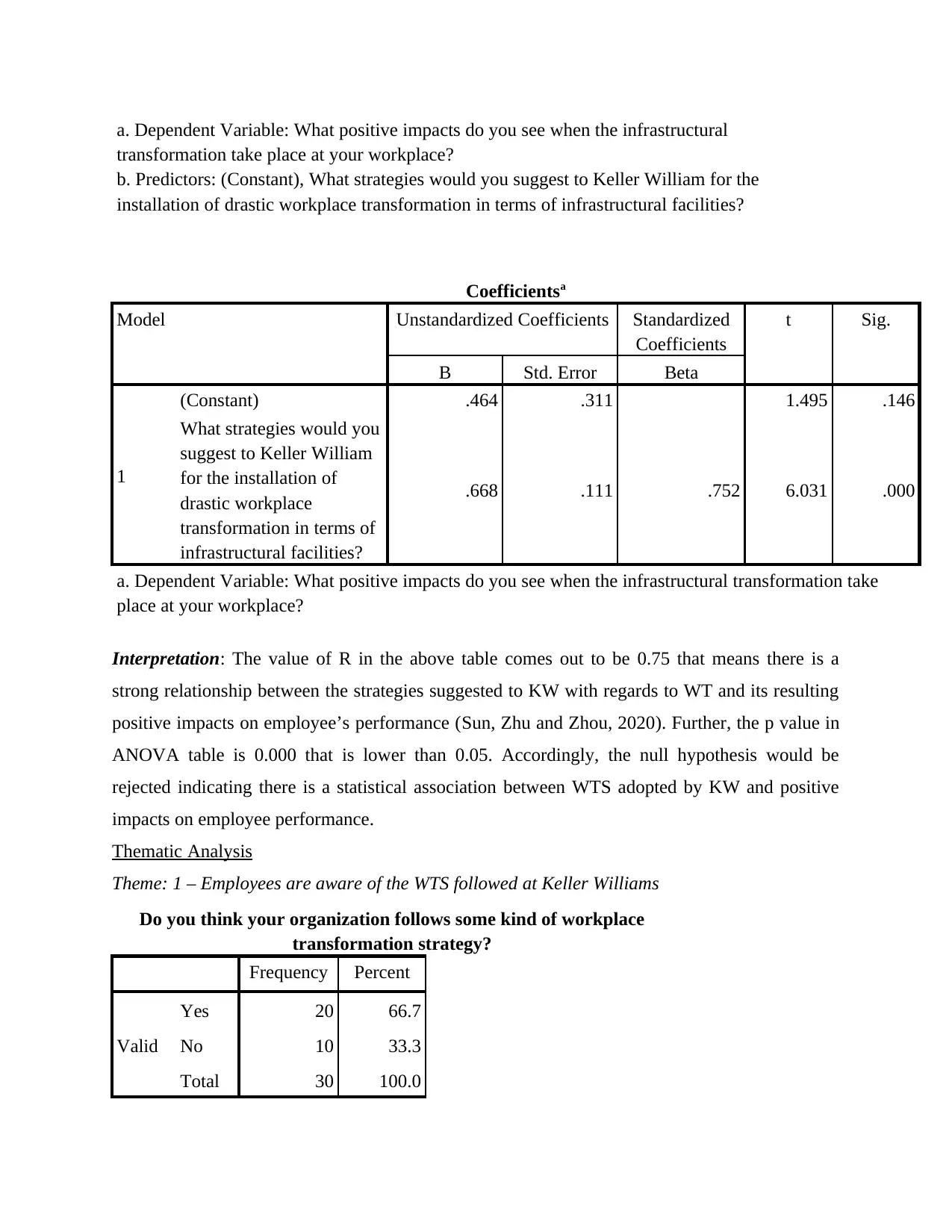
a. Dependent Variable: What positive impacts do you see when the infrastructural
transformation take place at your workplace?
b. Predictors: (Constant), What strategies would you suggest to Keller William for the
installation of drastic workplace transformation in terms of infrastructural facilities?
Coefficientsa
Model Unstandardized Coefficients Standardized
Coefficients
t Sig.
B Std. Error Beta
1
(Constant) .464 .311 1.495 .146
What strategies would you
suggest to Keller William
for the installation of
drastic workplace
transformation in terms of
infrastructural facilities?
.668 .111 .752 6.031 .000
a. Dependent Variable: What positive impacts do you see when the infrastructural transformation take
place at your workplace?
Interpretation: The value of R in the above table comes out to be 0.75 that means there is a
strong relationship between the strategies suggested to KW with regards to WT and its resulting
positive impacts on employee’s performance (Sun, Zhu and Zhou, 2020). Further, the p value in
ANOVA table is 0.000 that is lower than 0.05. Accordingly, the null hypothesis would be
rejected indicating there is a statistical association between WTS adopted by KW and positive
impacts on employee performance.
Thematic Analysis
Theme: 1 – Employees are aware of the WTS followed at Keller Williams
Do you think your organization follows some kind of workplace
transformation strategy?
Frequency Percent
Valid
Yes 20 66.7
No 10 33.3
Total 30 100.0
transformation take place at your workplace?
b. Predictors: (Constant), What strategies would you suggest to Keller William for the
installation of drastic workplace transformation in terms of infrastructural facilities?
Coefficientsa
Model Unstandardized Coefficients Standardized
Coefficients
t Sig.
B Std. Error Beta
1
(Constant) .464 .311 1.495 .146
What strategies would you
suggest to Keller William
for the installation of
drastic workplace
transformation in terms of
infrastructural facilities?
.668 .111 .752 6.031 .000
a. Dependent Variable: What positive impacts do you see when the infrastructural transformation take
place at your workplace?
Interpretation: The value of R in the above table comes out to be 0.75 that means there is a
strong relationship between the strategies suggested to KW with regards to WT and its resulting
positive impacts on employee’s performance (Sun, Zhu and Zhou, 2020). Further, the p value in
ANOVA table is 0.000 that is lower than 0.05. Accordingly, the null hypothesis would be
rejected indicating there is a statistical association between WTS adopted by KW and positive
impacts on employee performance.
Thematic Analysis
Theme: 1 – Employees are aware of the WTS followed at Keller Williams
Do you think your organization follows some kind of workplace
transformation strategy?
Frequency Percent
Valid
Yes 20 66.7
No 10 33.3
Total 30 100.0
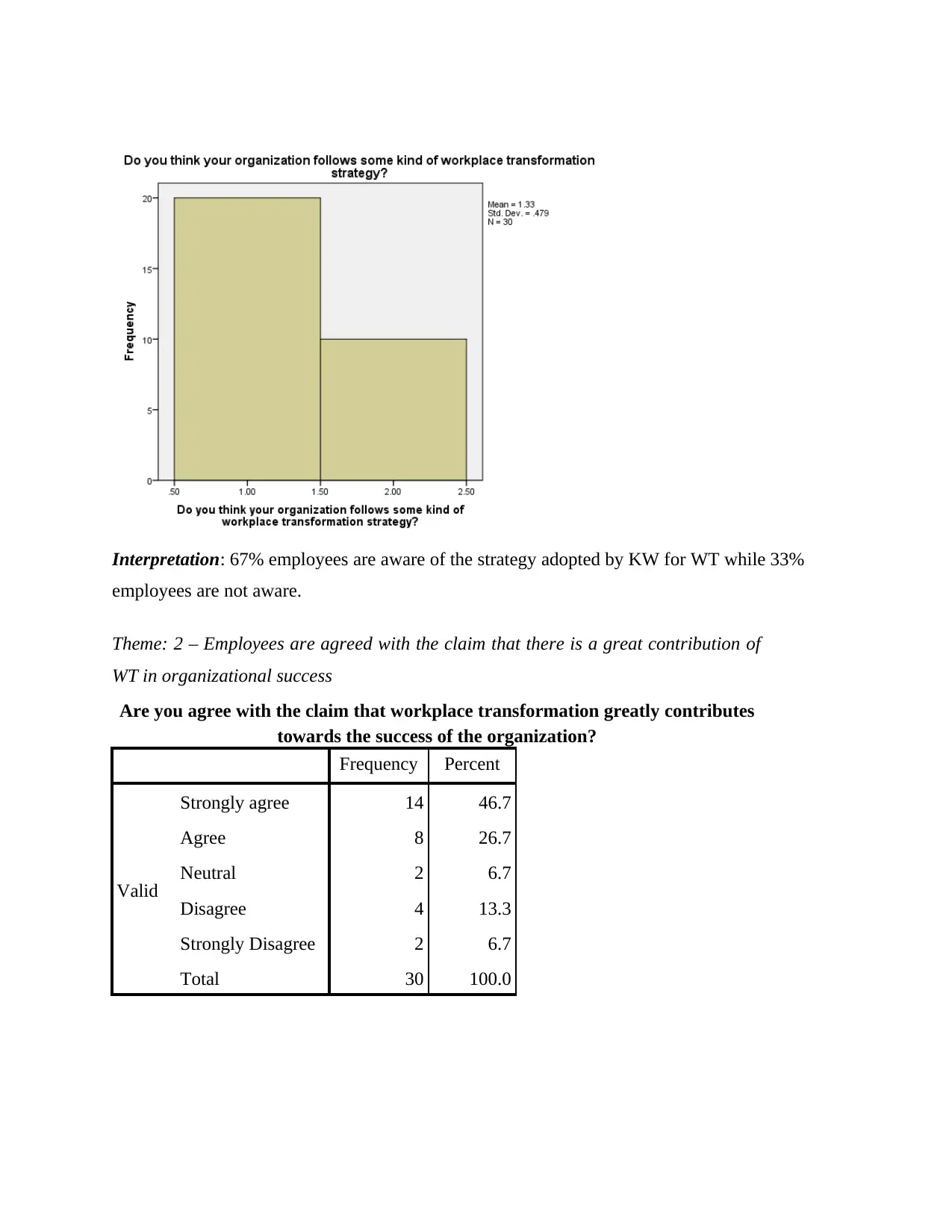
Interpretation: 67% employees are aware of the strategy adopted by KW for WT while 33%
employees are not aware.
Theme: 2 – Employees are agreed with the claim that there is a great contribution of
WT in organizational success
Are you agree with the claim that workplace transformation greatly contributes
towards the success of the organization?
Frequency Percent
Valid
Strongly agree 14 46.7
Agree 8 26.7
Neutral 2 6.7
Disagree 4 13.3
Strongly Disagree 2 6.7
Total 30 100.0
employees are not aware.
Theme: 2 – Employees are agreed with the claim that there is a great contribution of
WT in organizational success
Are you agree with the claim that workplace transformation greatly contributes
towards the success of the organization?
Frequency Percent
Valid
Strongly agree 14 46.7
Agree 8 26.7
Neutral 2 6.7
Disagree 4 13.3
Strongly Disagree 2 6.7
Total 30 100.0
Secure Best Marks with AI Grader
Need help grading? Try our AI Grader for instant feedback on your assignments.
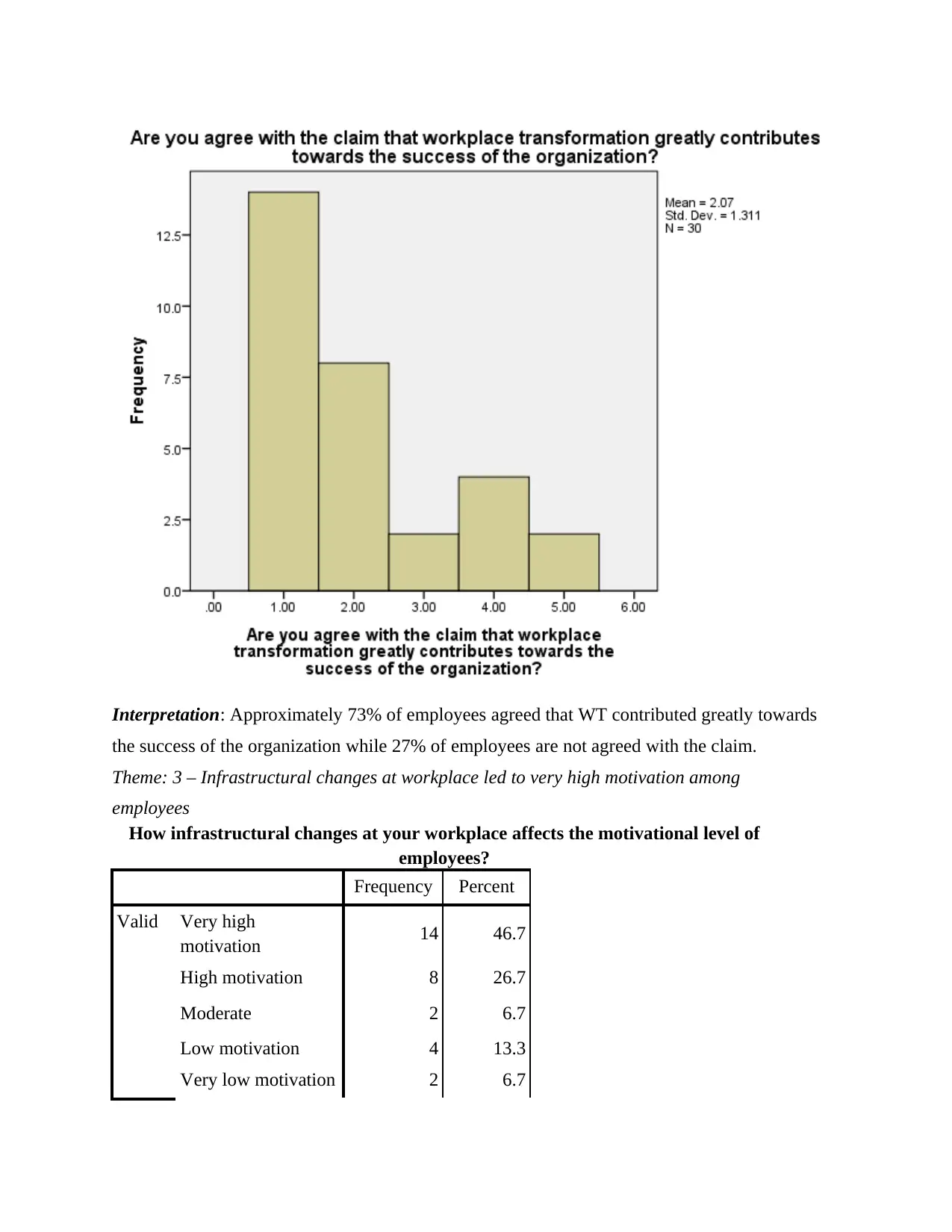
Interpretation: Approximately 73% of employees agreed that WT contributed greatly towards
the success of the organization while 27% of employees are not agreed with the claim.
Theme: 3 – Infrastructural changes at workplace led to very high motivation among
employees
How infrastructural changes at your workplace affects the motivational level of
employees?
Frequency Percent
Valid Very high
motivation 14 46.7
High motivation 8 26.7
Moderate 2 6.7
Low motivation 4 13.3
Very low motivation 2 6.7
the success of the organization while 27% of employees are not agreed with the claim.
Theme: 3 – Infrastructural changes at workplace led to very high motivation among
employees
How infrastructural changes at your workplace affects the motivational level of
employees?
Frequency Percent
Valid Very high
motivation 14 46.7
High motivation 8 26.7
Moderate 2 6.7
Low motivation 4 13.3
Very low motivation 2 6.7
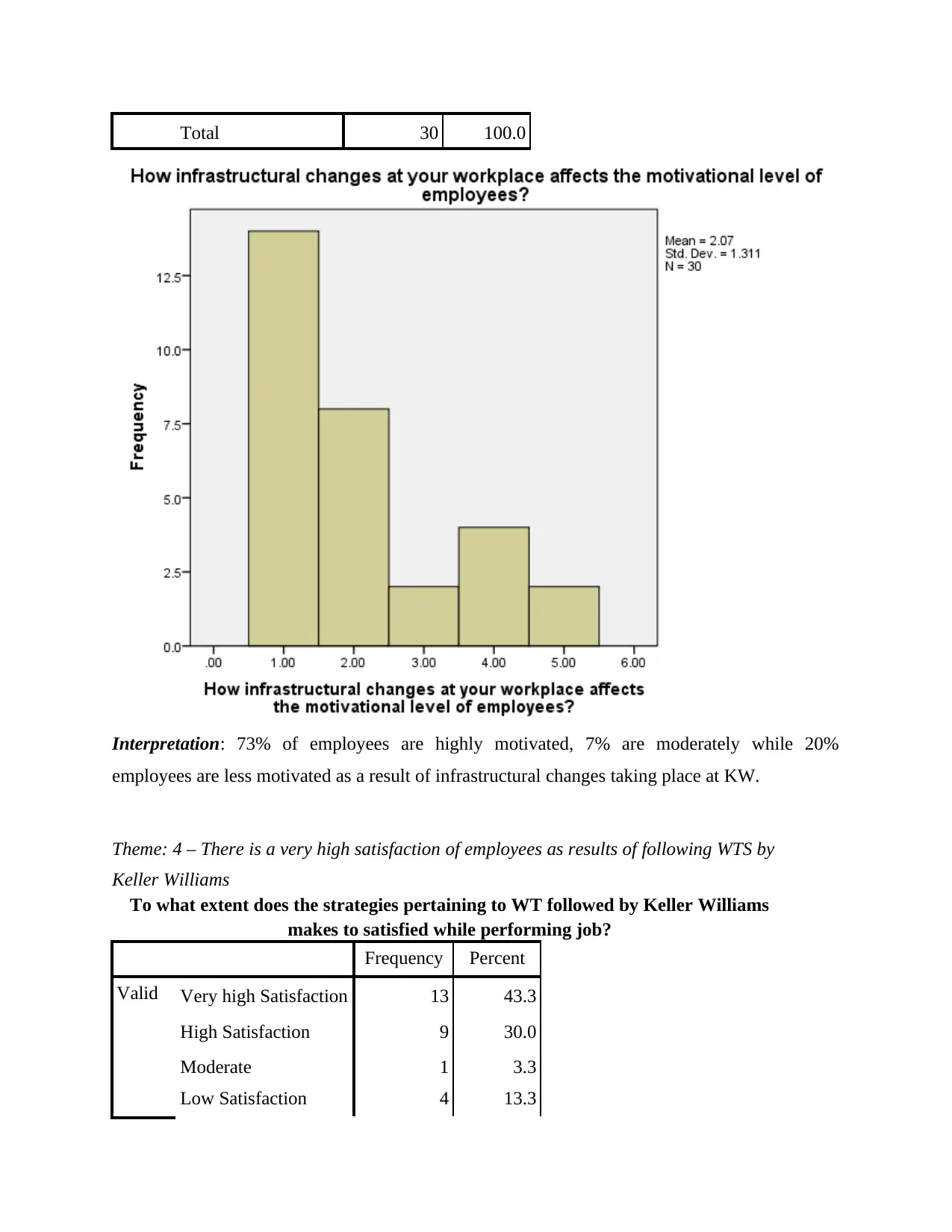
Total 30 100.0
Interpretation: 73% of employees are highly motivated, 7% are moderately while 20%
employees are less motivated as a result of infrastructural changes taking place at KW.
Theme: 4 – There is a very high satisfaction of employees as results of following WTS by
Keller Williams
To what extent does the strategies pertaining to WT followed by Keller Williams
makes to satisfied while performing job?
Frequency Percent
Valid Very high Satisfaction 13 43.3
High Satisfaction 9 30.0
Moderate 1 3.3
Low Satisfaction 4 13.3
Interpretation: 73% of employees are highly motivated, 7% are moderately while 20%
employees are less motivated as a result of infrastructural changes taking place at KW.
Theme: 4 – There is a very high satisfaction of employees as results of following WTS by
Keller Williams
To what extent does the strategies pertaining to WT followed by Keller Williams
makes to satisfied while performing job?
Frequency Percent
Valid Very high Satisfaction 13 43.3
High Satisfaction 9 30.0
Moderate 1 3.3
Low Satisfaction 4 13.3
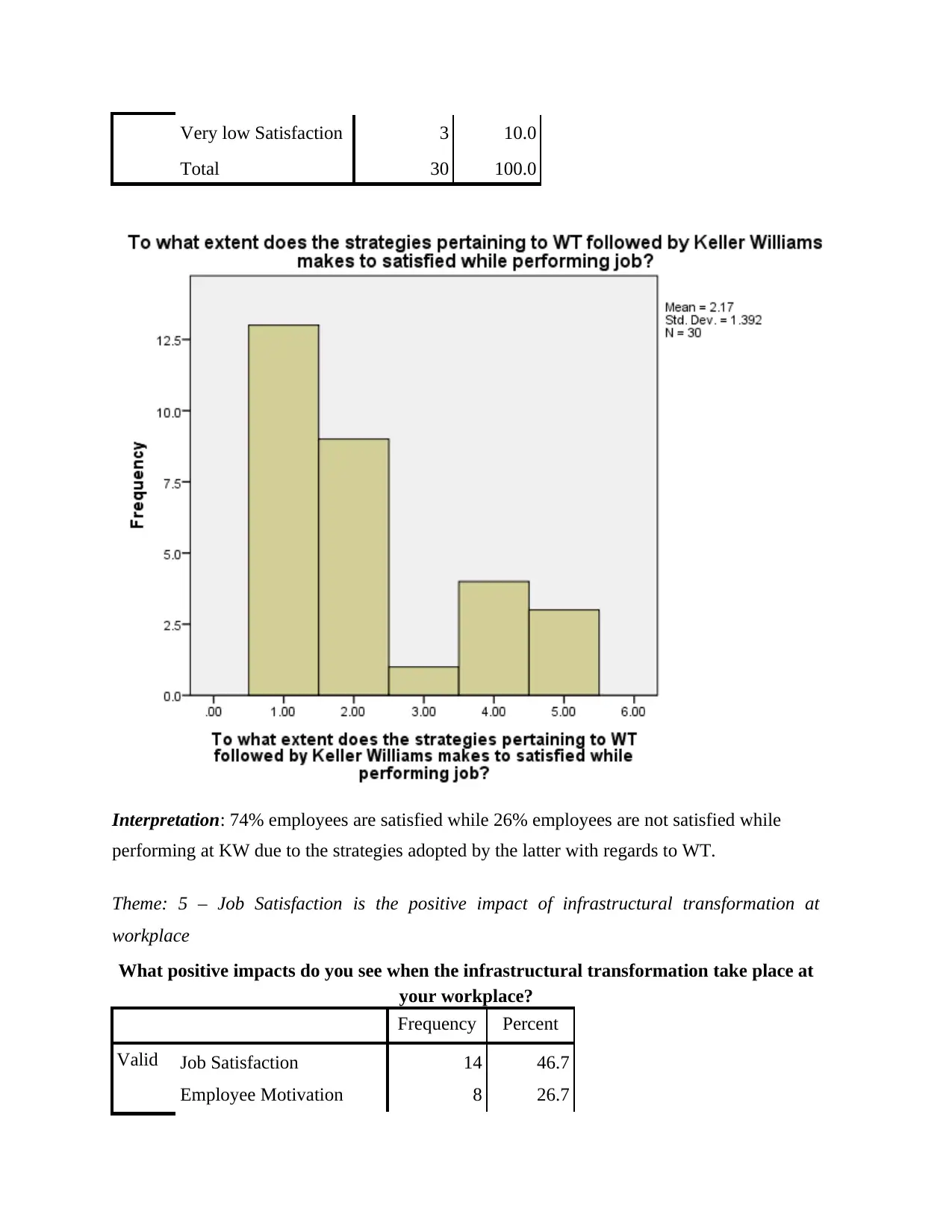
Very low Satisfaction 3 10.0
Total 30 100.0
Interpretation: 74% employees are satisfied while 26% employees are not satisfied while
performing at KW due to the strategies adopted by the latter with regards to WT.
Theme: 5 – Job Satisfaction is the positive impact of infrastructural transformation at
workplace
What positive impacts do you see when the infrastructural transformation take place at
your workplace?
Frequency Percent
Valid Job Satisfaction 14 46.7
Employee Motivation 8 26.7
Total 30 100.0
Interpretation: 74% employees are satisfied while 26% employees are not satisfied while
performing at KW due to the strategies adopted by the latter with regards to WT.
Theme: 5 – Job Satisfaction is the positive impact of infrastructural transformation at
workplace
What positive impacts do you see when the infrastructural transformation take place at
your workplace?
Frequency Percent
Valid Job Satisfaction 14 46.7
Employee Motivation 8 26.7
Paraphrase This Document
Need a fresh take? Get an instant paraphrase of this document with our AI Paraphraser
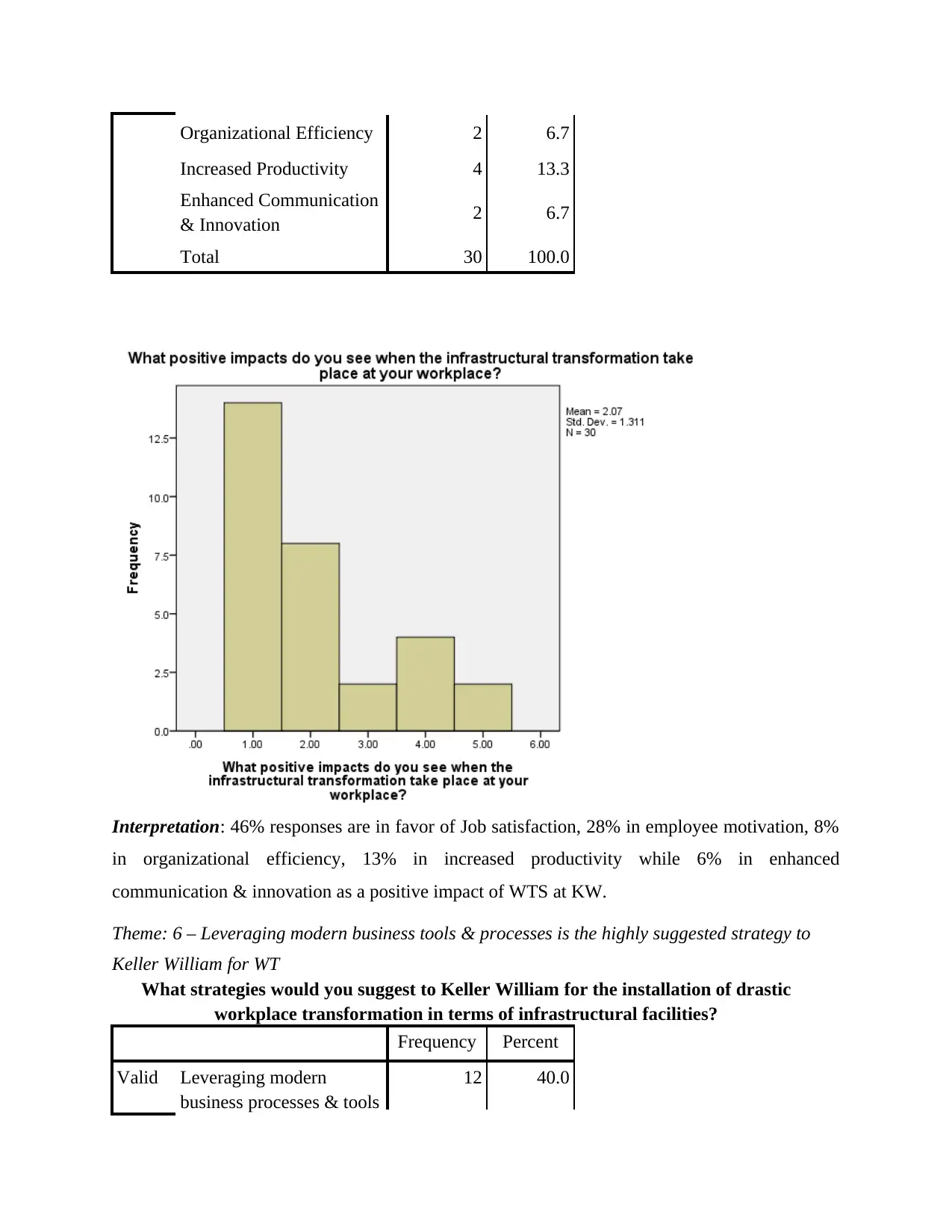
Organizational Efficiency 2 6.7
Increased Productivity 4 13.3
Enhanced Communication
& Innovation 2 6.7
Total 30 100.0
Interpretation: 46% responses are in favor of Job satisfaction, 28% in employee motivation, 8%
in organizational efficiency, 13% in increased productivity while 6% in enhanced
communication & innovation as a positive impact of WTS at KW.
Theme: 6 – Leveraging modern business tools & processes is the highly suggested strategy to
Keller William for WT
What strategies would you suggest to Keller William for the installation of drastic
workplace transformation in terms of infrastructural facilities?
Frequency Percent
Valid Leveraging modern
business processes & tools
12 40.0
Increased Productivity 4 13.3
Enhanced Communication
& Innovation 2 6.7
Total 30 100.0
Interpretation: 46% responses are in favor of Job satisfaction, 28% in employee motivation, 8%
in organizational efficiency, 13% in increased productivity while 6% in enhanced
communication & innovation as a positive impact of WTS at KW.
Theme: 6 – Leveraging modern business tools & processes is the highly suggested strategy to
Keller William for WT
What strategies would you suggest to Keller William for the installation of drastic
workplace transformation in terms of infrastructural facilities?
Frequency Percent
Valid Leveraging modern
business processes & tools
12 40.0
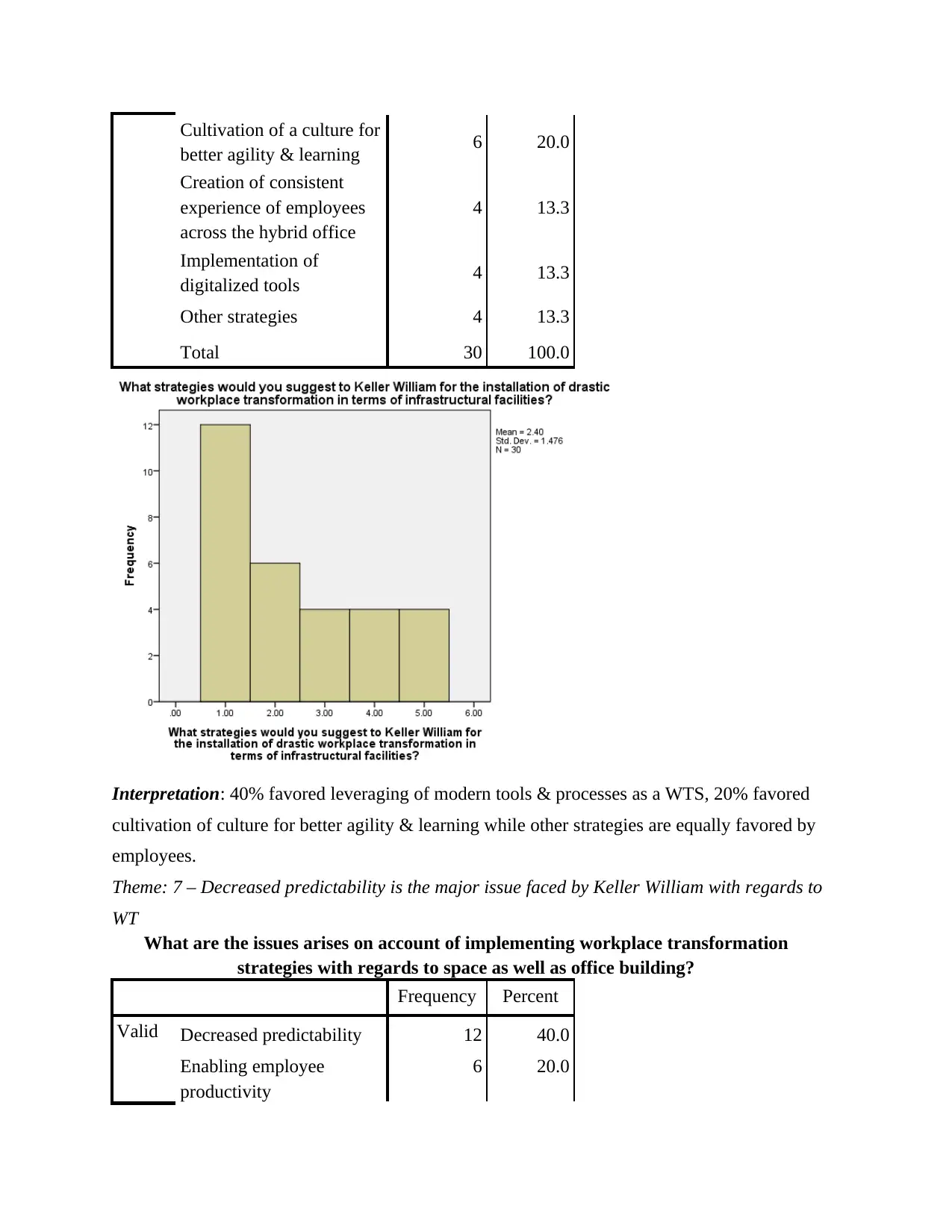
Cultivation of a culture for
better agility & learning 6 20.0
Creation of consistent
experience of employees
across the hybrid office
4 13.3
Implementation of
digitalized tools 4 13.3
Other strategies 4 13.3
Total 30 100.0
Interpretation: 40% favored leveraging of modern tools & processes as a WTS, 20% favored
cultivation of culture for better agility & learning while other strategies are equally favored by
employees.
Theme: 7 – Decreased predictability is the major issue faced by Keller William with regards to
WT
What are the issues arises on account of implementing workplace transformation
strategies with regards to space as well as office building?
Frequency Percent
Valid Decreased predictability 12 40.0
Enabling employee
productivity
6 20.0
better agility & learning 6 20.0
Creation of consistent
experience of employees
across the hybrid office
4 13.3
Implementation of
digitalized tools 4 13.3
Other strategies 4 13.3
Total 30 100.0
Interpretation: 40% favored leveraging of modern tools & processes as a WTS, 20% favored
cultivation of culture for better agility & learning while other strategies are equally favored by
employees.
Theme: 7 – Decreased predictability is the major issue faced by Keller William with regards to
WT
What are the issues arises on account of implementing workplace transformation
strategies with regards to space as well as office building?
Frequency Percent
Valid Decreased predictability 12 40.0
Enabling employee
productivity
6 20.0
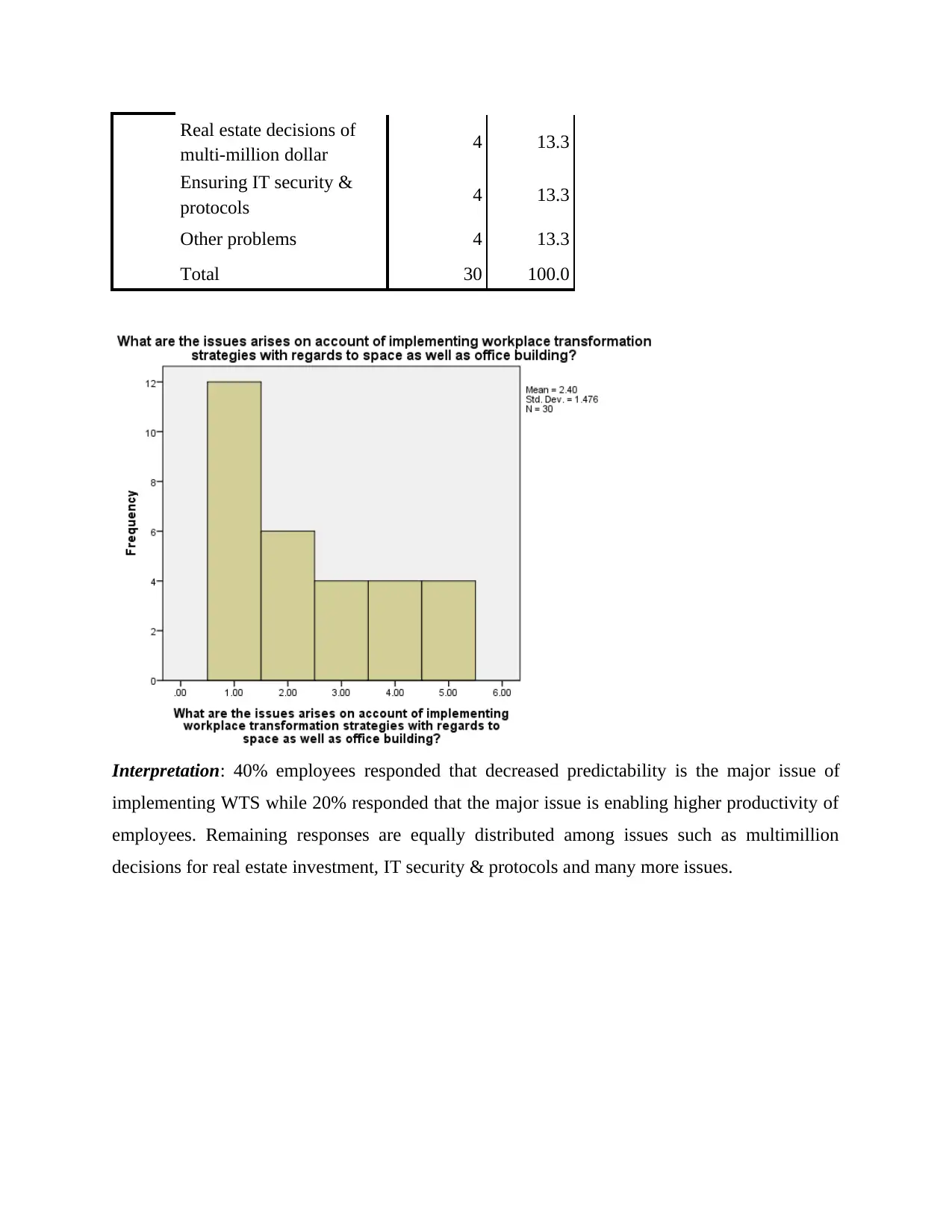
Real estate decisions of
multi-million dollar 4 13.3
Ensuring IT security &
protocols 4 13.3
Other problems 4 13.3
Total 30 100.0
Interpretation: 40% employees responded that decreased predictability is the major issue of
implementing WTS while 20% responded that the major issue is enabling higher productivity of
employees. Remaining responses are equally distributed among issues such as multimillion
decisions for real estate investment, IT security & protocols and many more issues.
multi-million dollar 4 13.3
Ensuring IT security &
protocols 4 13.3
Other problems 4 13.3
Total 30 100.0
Interpretation: 40% employees responded that decreased predictability is the major issue of
implementing WTS while 20% responded that the major issue is enabling higher productivity of
employees. Remaining responses are equally distributed among issues such as multimillion
decisions for real estate investment, IT security & protocols and many more issues.
Secure Best Marks with AI Grader
Need help grading? Try our AI Grader for instant feedback on your assignments.
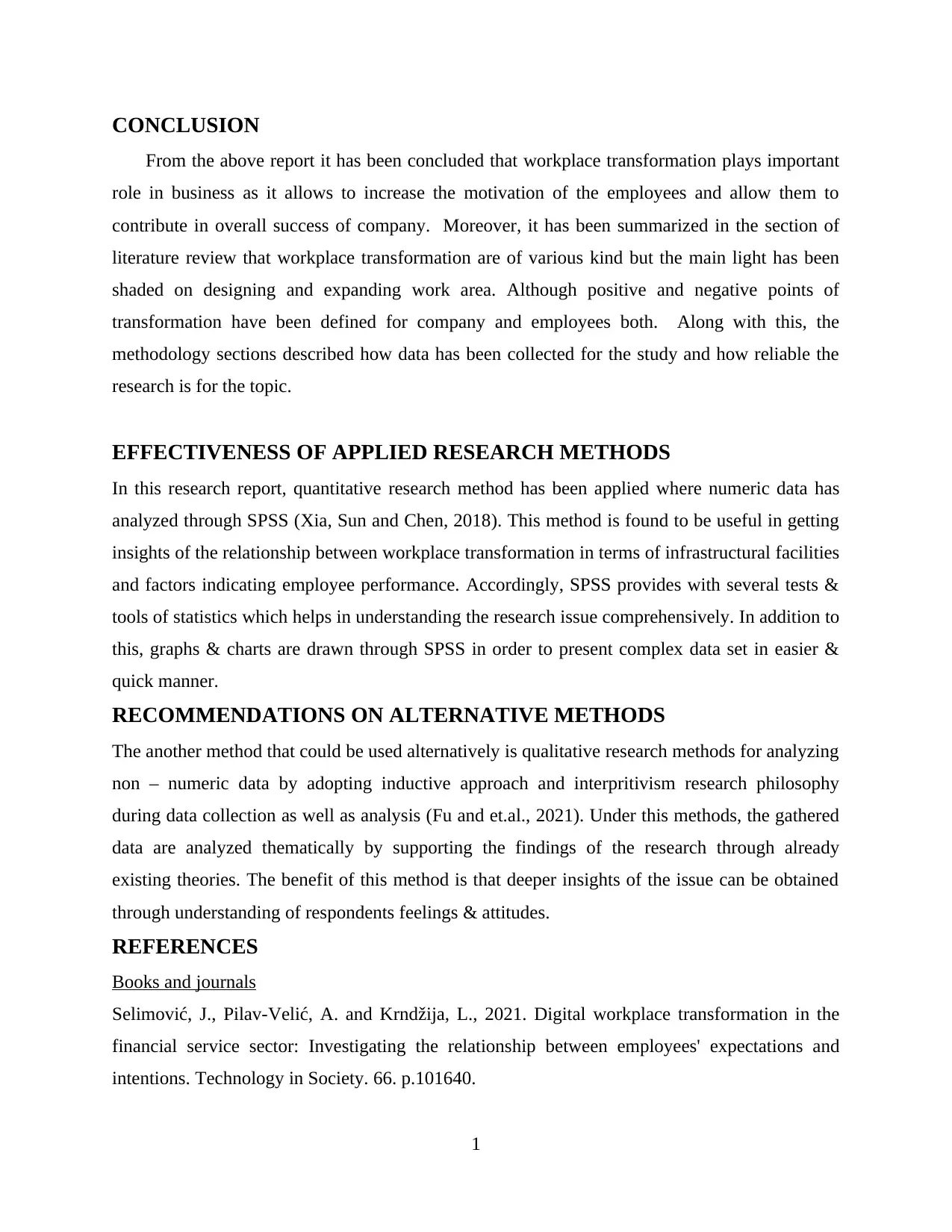
CONCLUSION
From the above report it has been concluded that workplace transformation plays important
role in business as it allows to increase the motivation of the employees and allow them to
contribute in overall success of company. Moreover, it has been summarized in the section of
literature review that workplace transformation are of various kind but the main light has been
shaded on designing and expanding work area. Although positive and negative points of
transformation have been defined for company and employees both. Along with this, the
methodology sections described how data has been collected for the study and how reliable the
research is for the topic.
EFFECTIVENESS OF APPLIED RESEARCH METHODS
In this research report, quantitative research method has been applied where numeric data has
analyzed through SPSS (Xia, Sun and Chen, 2018). This method is found to be useful in getting
insights of the relationship between workplace transformation in terms of infrastructural facilities
and factors indicating employee performance. Accordingly, SPSS provides with several tests &
tools of statistics which helps in understanding the research issue comprehensively. In addition to
this, graphs & charts are drawn through SPSS in order to present complex data set in easier &
quick manner.
RECOMMENDATIONS ON ALTERNATIVE METHODS
The another method that could be used alternatively is qualitative research methods for analyzing
non – numeric data by adopting inductive approach and interpritivism research philosophy
during data collection as well as analysis (Fu and et.al., 2021). Under this methods, the gathered
data are analyzed thematically by supporting the findings of the research through already
existing theories. The benefit of this method is that deeper insights of the issue can be obtained
through understanding of respondents feelings & attitudes.
REFERENCES
Books and journals
Selimović, J., Pilav-Velić, A. and Krndžija, L., 2021. Digital workplace transformation in the
financial service sector: Investigating the relationship between employees' expectations and
intentions. Technology in Society. 66. p.101640.
1
From the above report it has been concluded that workplace transformation plays important
role in business as it allows to increase the motivation of the employees and allow them to
contribute in overall success of company. Moreover, it has been summarized in the section of
literature review that workplace transformation are of various kind but the main light has been
shaded on designing and expanding work area. Although positive and negative points of
transformation have been defined for company and employees both. Along with this, the
methodology sections described how data has been collected for the study and how reliable the
research is for the topic.
EFFECTIVENESS OF APPLIED RESEARCH METHODS
In this research report, quantitative research method has been applied where numeric data has
analyzed through SPSS (Xia, Sun and Chen, 2018). This method is found to be useful in getting
insights of the relationship between workplace transformation in terms of infrastructural facilities
and factors indicating employee performance. Accordingly, SPSS provides with several tests &
tools of statistics which helps in understanding the research issue comprehensively. In addition to
this, graphs & charts are drawn through SPSS in order to present complex data set in easier &
quick manner.
RECOMMENDATIONS ON ALTERNATIVE METHODS
The another method that could be used alternatively is qualitative research methods for analyzing
non – numeric data by adopting inductive approach and interpritivism research philosophy
during data collection as well as analysis (Fu and et.al., 2021). Under this methods, the gathered
data are analyzed thematically by supporting the findings of the research through already
existing theories. The benefit of this method is that deeper insights of the issue can be obtained
through understanding of respondents feelings & attitudes.
REFERENCES
Books and journals
Selimović, J., Pilav-Velić, A. and Krndžija, L., 2021. Digital workplace transformation in the
financial service sector: Investigating the relationship between employees' expectations and
intentions. Technology in Society. 66. p.101640.
1
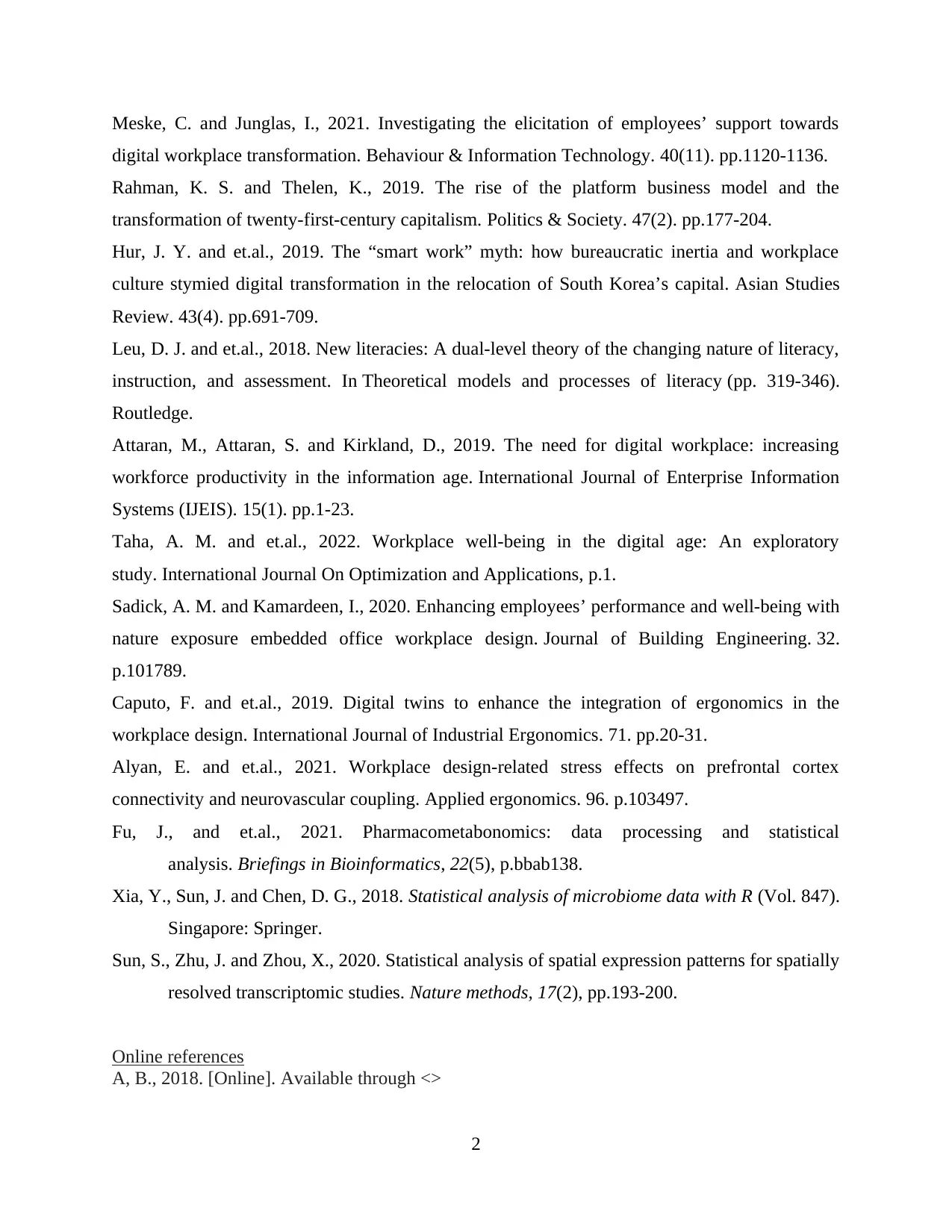
Meske, C. and Junglas, I., 2021. Investigating the elicitation of employees’ support towards
digital workplace transformation. Behaviour & Information Technology. 40(11). pp.1120-1136.
Rahman, K. S. and Thelen, K., 2019. The rise of the platform business model and the
transformation of twenty-first-century capitalism. Politics & Society. 47(2). pp.177-204.
Hur, J. Y. and et.al., 2019. The “smart work” myth: how bureaucratic inertia and workplace
culture stymied digital transformation in the relocation of South Korea’s capital. Asian Studies
Review. 43(4). pp.691-709.
Leu, D. J. and et.al., 2018. New literacies: A dual-level theory of the changing nature of literacy,
instruction, and assessment. In Theoretical models and processes of literacy (pp. 319-346).
Routledge.
Attaran, M., Attaran, S. and Kirkland, D., 2019. The need for digital workplace: increasing
workforce productivity in the information age. International Journal of Enterprise Information
Systems (IJEIS). 15(1). pp.1-23.
Taha, A. M. and et.al., 2022. Workplace well-being in the digital age: An exploratory
study. International Journal On Optimization and Applications, p.1.
Sadick, A. M. and Kamardeen, I., 2020. Enhancing employees’ performance and well-being with
nature exposure embedded office workplace design. Journal of Building Engineering. 32.
p.101789.
Caputo, F. and et.al., 2019. Digital twins to enhance the integration of ergonomics in the
workplace design. International Journal of Industrial Ergonomics. 71. pp.20-31.
Alyan, E. and et.al., 2021. Workplace design-related stress effects on prefrontal cortex
connectivity and neurovascular coupling. Applied ergonomics. 96. p.103497.
Fu, J., and et.al., 2021. Pharmacometabonomics: data processing and statistical
analysis. Briefings in Bioinformatics, 22(5), p.bbab138.
Xia, Y., Sun, J. and Chen, D. G., 2018. Statistical analysis of microbiome data with R (Vol. 847).
Singapore: Springer.
Sun, S., Zhu, J. and Zhou, X., 2020. Statistical analysis of spatial expression patterns for spatially
resolved transcriptomic studies. Nature methods, 17(2), pp.193-200.
Online references
A, B., 2018. [Online]. Available through <>
2
digital workplace transformation. Behaviour & Information Technology. 40(11). pp.1120-1136.
Rahman, K. S. and Thelen, K., 2019. The rise of the platform business model and the
transformation of twenty-first-century capitalism. Politics & Society. 47(2). pp.177-204.
Hur, J. Y. and et.al., 2019. The “smart work” myth: how bureaucratic inertia and workplace
culture stymied digital transformation in the relocation of South Korea’s capital. Asian Studies
Review. 43(4). pp.691-709.
Leu, D. J. and et.al., 2018. New literacies: A dual-level theory of the changing nature of literacy,
instruction, and assessment. In Theoretical models and processes of literacy (pp. 319-346).
Routledge.
Attaran, M., Attaran, S. and Kirkland, D., 2019. The need for digital workplace: increasing
workforce productivity in the information age. International Journal of Enterprise Information
Systems (IJEIS). 15(1). pp.1-23.
Taha, A. M. and et.al., 2022. Workplace well-being in the digital age: An exploratory
study. International Journal On Optimization and Applications, p.1.
Sadick, A. M. and Kamardeen, I., 2020. Enhancing employees’ performance and well-being with
nature exposure embedded office workplace design. Journal of Building Engineering. 32.
p.101789.
Caputo, F. and et.al., 2019. Digital twins to enhance the integration of ergonomics in the
workplace design. International Journal of Industrial Ergonomics. 71. pp.20-31.
Alyan, E. and et.al., 2021. Workplace design-related stress effects on prefrontal cortex
connectivity and neurovascular coupling. Applied ergonomics. 96. p.103497.
Fu, J., and et.al., 2021. Pharmacometabonomics: data processing and statistical
analysis. Briefings in Bioinformatics, 22(5), p.bbab138.
Xia, Y., Sun, J. and Chen, D. G., 2018. Statistical analysis of microbiome data with R (Vol. 847).
Singapore: Springer.
Sun, S., Zhu, J. and Zhou, X., 2020. Statistical analysis of spatial expression patterns for spatially
resolved transcriptomic studies. Nature methods, 17(2), pp.193-200.
Online references
A, B., 2018. [Online]. Available through <>
2

3
1 out of 19
Related Documents
Your All-in-One AI-Powered Toolkit for Academic Success.
+13062052269
info@desklib.com
Available 24*7 on WhatsApp / Email
![[object Object]](/_next/static/media/star-bottom.7253800d.svg)
Unlock your academic potential
© 2024 | Zucol Services PVT LTD | All rights reserved.



